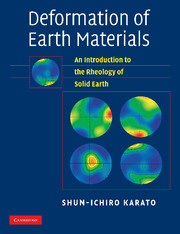Book contents
- Frontmatter
- Contents
- Preface
- Part I General background
- Part II Materials science of deformation
- Part III Geological and geophysical applications
- 17 Composition and structure of Earth's interior
- 18 Inference of rheological structure of Earth from time-dependent deformation
- 19 Inference of rheological structure of Earth from mineral physics
- 20 Heterogeneity of Earth structure and its geodynamic implications
- 21 Seismic anisotropy and its geodynamic implications
- References
- Materials index
- Subject index
- Plate section
19 - Inference of rheological structure of Earth from mineral physics
Published online by Cambridge University Press: 05 June 2012
- Frontmatter
- Contents
- Preface
- Part I General background
- Part II Materials science of deformation
- Part III Geological and geophysical applications
- 17 Composition and structure of Earth's interior
- 18 Inference of rheological structure of Earth from time-dependent deformation
- 19 Inference of rheological structure of Earth from mineral physics
- 20 Heterogeneity of Earth structure and its geodynamic implications
- 21 Seismic anisotropy and its geodynamic implications
- References
- Materials index
- Subject index
- Plate section
Summary
The current status of our understanding of the rheological structure of Earth's interior from a mineral physics point of view is reviewed. The rheological structure of the lithosphere–asthenosphere system is discussed in detail as well as the rheological structure of the deep mantle and the inner core. The inferred rheological structures depend critically on the temperature, water content, grain size and stress as well as the constitutive relations that control the dependence of rheological properties on these variables. These variables can be inferred for the shallow portions of Earth and some detailed analyses of the rheological structures there are presented including the regional variation in the rheological structure of the lithosphere. In contrast, temperature, water content and grain size are poorly known for Earth's deep interior. In addition, some of the important material parameters for deep Earth materials that determine the sensitivity of the rheological properties on these variables are not well constrained. Consequently, the inference of the rheological structure of Earth's deep interior can only be made with large uncertainties. In these cases, emphasis is placed on the basic framework by which rheological structures of Earth may be inferred from mineral physics rather than on specific models.
Keywords lithosphere, asthenosphere, partial melting, phase transformations, water, grain size.
Introduction
Similar to any other physical properties, the rheological properties in Earth and other terrestrial planets change both radially and laterally, and the manner in which the rheological properties change in space (and possibly in time) is highly dependent on the physical mechanisms of deformation.
- Type
- Chapter
- Information
- Deformation of Earth MaterialsAn Introduction to the Rheology of Solid Earth, pp. 338 - 362Publisher: Cambridge University PressPrint publication year: 2008



